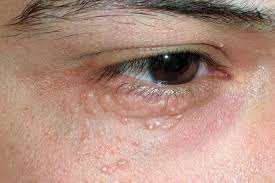Milia, commonly known as milk spots, are small, white bumps that often appear on the face, particularly around the eyes, nose, and cheeks. These tiny cysts form when keratin becomes trapped beneath the surface of the skin. While milia are generally harmless, they can be cosmetically bothersome, leading many individuals to seek out solutions for their removal. Let's delve into milia dermatologist.
The Importance of Professional Advice
Before attempting to extract milia at home, it's essential to consult with a dermatologist. Dermatologists are medical experts trained in the diagnosis and treatment of various skin conditions, including milia. Their guidance is invaluable in determining the most suitable approach for dealing with these stubborn bumps.
Consulting a Dermatologist: What to Expect
During a consultation with a dermatologist, individuals can expect a thorough examination of their skin to assess the extent of the milia and identify any underlying factors contributing to their formation. Based on this evaluation, the dermatologist may recommend a range of treatment options, including professional extraction using specialized tools.
Milia Extraction Tools: Insights from Dermatologists
Dermatologists employ various tools and techniques for safely and effectively removing milia. While some tools are designed for use in clinical settings by trained professionals, others are marketed for at-home use. However, the efficacy and safety of these tools can vary significantly, prompting dermatologists to offer their insights and recommendations.
Professional Milia Extraction Tools
In clinical settings, dermatologists often utilize specialized tools to extract milia with precision and minimal risk of scarring or infection. These tools may include:
1. Lancets
Lancets are small, sharp instruments that dermatologists use to create a tiny incision in the skin overlying the milia. This allows for the gentle extraction of the trapped keratin without causing damage to the surrounding tissue.
2. Comedone Extractors
Comedone extractors, also known as blackhead or whitehead extractors, are commonly used by dermatologists to remove milia and other types of non-inflammatory acne lesions. These tools feature a small loop or spoon-shaped end designed to apply gentle pressure around the milia, facilitating their release from the skin.
3. Microdermabrasion
Microdermabrasion is a non-invasive exfoliation technique that can help improve the appearance of milia by gently removing the outer layer of dead skin cells. Dermatologists may use microdermabrasion in combination with other treatments to enhance the results of milia extraction.
At-Home Milia Extraction Tools: Proceed with Caution
While there are numerous tools and devices marketed for at-home milia extraction, dermatologists caution against DIY removal without proper training and guidance. Using the wrong tools or techniques can lead to complications such as infection, scarring, or exacerbation of the condition.
1. Extractor Kits
Some at-home milia extraction kits may include tools similar to those used by dermatologists, such as lancets or comedone extractors. However, without proper knowledge and skill, individuals may inadvertently cause harm to their skin.
2. Scrubs and Exfoliants
Certain skincare products, such as scrubs and exfoliating acids, claim to help dislodge and remove milia by promoting cellular turnover. While gentle exfoliation can be beneficial for overall skin health, aggressive scrubbing or overuse of exfoliants can irritate the skin and worsen the appearance of milia.
Conclusion: The Importance of Professional Guidance
In conclusion, while milia extraction tools may offer a tempting solution for addressing these pesky bumps, it's crucial to seek the guidance of a qualified dermatologist before attempting any removal procedures. Dermatologists possess the expertise and experience necessary to safely extract milia and minimize the risk of complications. By consulting with a dermatologist, individuals can ensure that their skincare regimen is tailored to their specific needs, leading to clearer, healthier skin in the long run.





Comments